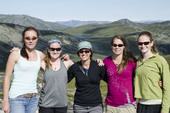Highlight
Science in Greenland: It's a Girl Thing
Achievement/Results
A significant component of the Dartmouth IGERT in Polar Environmental Change is a 5-week field experience in Greenland during the summer. Graduate students from earth sciences, ecology and evolutionary biology, and engineering work together in the field in three Greenland locations, each of which provides unique and significant scientific, engineering, and communication challenges. The field seminar is where a student’s commitment to field research and communication tests their personal motivation and determination for success. The field seminar is intellectually and physically demanding and it requires patience and persistence.
In 2012, near the end of the field seminar, the all-female IGERT cohort was introduced to a promotional video created by the European Commission, called “Science: It’s a Girl Thing,” as a part of an EC campaign to inspire more girls and young women to get involved in science. While well-intentioned, the video featured scenes of women in short skirts, lipstick, and high heels interspersed with a scene showing one male “real scientist.” Needless to say, the EC’s video created a firestorm of controversy; they subsequently removed it from their website. The incident inspired the Dartmouth IGERT cohort—which coincidentally was all-female—to shoot and edit their own “Science in Greenland: It’s a Girl Thing” video.
The graduate students—Lee Corbett (earth sciences), Jessica Trout-Haney (ecology), Chelsea Vario (ecology), Steph Gregory (engineering), and Ali Giese (earth sciences)—along with Greenland Field Seminar Research Assistant Courtney Hammond, quickly shot footage in the field while preparing for packing up and leaving Greenland on a C-130 cargo plane. Back at Dartmouth, the students produced a video that in only one-minute, 35-seconds demonstrated their enthusiasm for science and the real excitement of working in the field as a team. After uploading their video to the Dartmouth IGERT blog, it went viral and has been viewed by thousands. Media outlets as diverse as the Huffington Post, the Boston Globe and Andy Revkin’s New York Times dotearth blog wrote about it, as did academic institutions such as the University of British Columbia.
Although the video begins with an ironic and humorous parody of the original EC video’s failings, it quickly focuses on the real excitement of doing science in field. Even the EC.’s Science: It’s a Girl Thing! Campaign Team responded positively to the Dartmouth video: “We are glad to see another video made by young women to encourage girls to take up science. To be fair, having such a controversial video was not our original intent… However, if there is one positive thing to have emerged, it is the wider debate on women in science that it has provoked.” Ross Virginia, the Myers Family Professor of Environmental Science and director of the IGERT program, said the video has “energized the ongoing debate about how to attract young women to science and how to support rewarding career paths for them.” Dartmouth President Carol Folt had words of praise for the video and its creators: “Science in Greenland is lots of fun,” said Folt. “It focuses on the talent and commitment of Dartmouth’s scientists, and communicates a passion for scientific research to girls and young women who are considering a career in science.”
In a story about their video posted on the Dartmouth website, students featured in the video reflected on their ultimate purpose in making the video, which they originally thought might only be shown to a class or two and their friends, and never imagined would garner a worldwide audience. “We just wanted to draw attention to an alternative way to be a strong female and do science,” said IGERT Jessica Trout-Haney. “We can still be fun, social women who enjoy lots of adventures and laughs in the field. But at the end of the day, we’re all doing serious scientific research and making meaningful contributions to our fields,” said IGERT Lee Corbett.
Address Goals
In less than a minute and a half, the “Science in Greenland: It’s a Girl Thing” video demonstrates for girls and women, as well as boys and men, how science can be exciting, fun, and inspiring. The video breaks the mold of what a scientist looks like and what scientific and engineering work is. It also demonstrates sampling collection and other techniques that are not usually seen by the general public. Only by breaking down barriers and providing strong role models will more students, the best and the brightest, consider careers in science.







